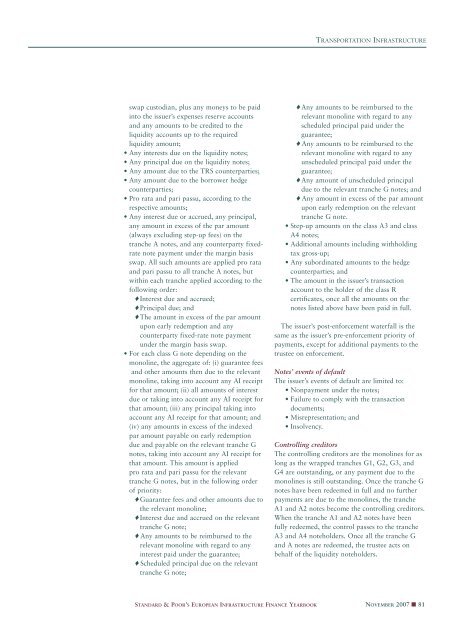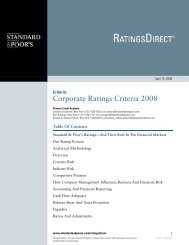European Infrastructure Finance Yearbook - Investing In Bonds ...
European Infrastructure Finance Yearbook - Investing In Bonds ...
European Infrastructure Finance Yearbook - Investing In Bonds ...
Create successful ePaper yourself
Turn your PDF publications into a flip-book with our unique Google optimized e-Paper software.
swap custodian, plus any moneys to be paid<br />
into the issuer’s expenses reserve accounts<br />
and any amounts to be credited to the<br />
liquidity accounts up to the required<br />
liquidity amount;<br />
• Any interests due on the liquidity notes;<br />
• Any principal due on the liquidity notes;<br />
• Any amount due to the TRS counterparties;<br />
• Any amount due to the borrower hedge<br />
counterparties;<br />
• Pro rata and pari passu, according to the<br />
respective amounts;<br />
• Any interest due or accrued, any principal,<br />
any amount in excess of the par amount<br />
(always excluding step-up fees) on the<br />
tranche A notes, and any counterparty fixedrate<br />
note payment under the margin basis<br />
swap. All such amounts are applied pro rata<br />
and pari passu to all tranche A notes, but<br />
within each tranche applied according to the<br />
following order:<br />
♦ <strong>In</strong>terest due and accrued;<br />
♦ Principal due; and<br />
♦ The amount in excess of the par amount<br />
upon early redemption and any<br />
counterparty fixed-rate note payment<br />
under the margin basis swap.<br />
• For each class G note depending on the<br />
monoline, the aggregate of: (i) guarantee fees<br />
and other amounts then due to the relevant<br />
monoline, taking into account any AI receipt<br />
for that amount; (ii) all amounts of interest<br />
due or taking into account any AI receipt for<br />
that amount; (iii) any principal taking into<br />
account any AI receipt for that amount; and<br />
(iv) any amounts in excess of the indexed<br />
par amount payable on early redemption<br />
due and payable on the relevant tranche G<br />
notes, taking into account any AI receipt for<br />
that amount. This amount is applied<br />
pro rata and pari passu for the relevant<br />
tranche G notes, but in the following order<br />
of priority:<br />
♦ Guarantee fees and other amounts due to<br />
the relevant monoline;<br />
♦ <strong>In</strong>terest due and accrued on the relevant<br />
tranche G note;<br />
♦ Any amounts to be reimbursed to the<br />
relevant monoline with regard to any<br />
interest paid under the guarantee;<br />
♦ Scheduled principal due on the relevant<br />
tranche G note;<br />
STANDARD & POOR’S EUROPEAN INFRASTRUCTURE FINANCE YEARBOOK<br />
TRANSPORTATION INFRASTRUCTURE<br />
♦ Any amounts to be reimbursed to the<br />
relevant monoline with regard to any<br />
scheduled principal paid under the<br />
guarantee;<br />
♦ Any amounts to be reimbursed to the<br />
relevant monoline with regard to any<br />
unscheduled principal paid under the<br />
guarantee;<br />
♦ Any amount of unscheduled principal<br />
due to the relevant tranche G notes; and<br />
♦ Any amount in excess of the par amount<br />
upon early redemption on the relevant<br />
tranche G note.<br />
• Step-up amounts on the class A3 and class<br />
A4 notes;<br />
• Additional amounts including withholding<br />
tax gross-up;<br />
• Any subordinated amounts to the hedge<br />
counterparties; and<br />
• The amount in the issuer’s transaction<br />
account to the holder of the class R<br />
certificates, once all the amounts on the<br />
notes listed above have been paid in full.<br />
The issuer’s post-enforcement waterfall is the<br />
same as the issuer’s pre-enforcement priority of<br />
payments, except for additional payments to the<br />
trustee on enforcement.<br />
Notes’ events of default<br />
The issuer’s events of default are limited to:<br />
• Nonpayment under the notes;<br />
• Failure to comply with the transaction<br />
documents;<br />
• Misrepresentation; and<br />
• <strong>In</strong>solvency.<br />
Controlling creditors<br />
The controlling creditors are the monolines for as<br />
long as the wrapped tranches G1, G2, G3, and<br />
G4 are outstanding, or any payment due to the<br />
monolines is still outstanding. Once the tranche G<br />
notes have been redeemed in full and no further<br />
payments are due to the monolines, the tranche<br />
A1 and A2 notes become the controlling creditors.<br />
When the tranche A1 and A2 notes have been<br />
fully redeemed, the control passes to the tranche<br />
A3 and A4 noteholders. Once all the tranche G<br />
and A notes are redeemed, the trustee acts on<br />
behalf of the liquidity noteholders.<br />
NOVEMBER 2007 ■ 81



